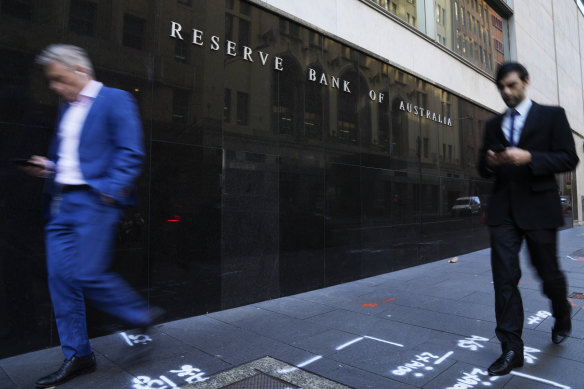Australia faces “stagflation-lite” after the Reserve Bank revealed it expects the economy to slow sharply, unemployment to rise and inflation to remain above its own target band until 2025 even as interest rates slash household spending.
Forecasting the worst two consecutive years of economic growth since the recession of 1990-91, the RBA on Friday said charities were reporting that renters and new home buyers were increasingly seeking help to cover bills and the growing cost of living.
The Reserve Bank is forecasting slower growth, higher inflation and a lift in unemployment.Credit:Mark Baker
CommSec chief equities economist Craig James said the RBA’s revised forecasts were a portent of stagflation – when economic growth slows and inflation remains high.
“Australia is not headed for stagflation, perhaps ‘stagflation-lite’. Slow economic growth and persistently higher than desired inflation is every central bankers’ nightmare,” he said.
The Reserve has lifted interest rates from 0.1 per cent at the start of May to 2.85 per cent this week, with markets expecting further increases as the bank seeks to bring inflation under control.
But in its quarterly monetary policy report, the bank forecast inflation to peak at 8 per cent this year and then gradually ease for the next two years. It believes inflation will be at 3.2 per cent by Christmas 2024, above its 2-3 per cent target band.
While inflation will be higher, the increases in interest rates will materially slow the economy, which is expected to grow by 1.4 per cent next year and 1.6 per cent through 2025. The last time the economy experienced such low growth over two consecutive years was at the start of the 1990s, when official interest rates were above 17 per cent.
Household spending, now running at 6 per cent, is tipped to pull back to just 1.3 per cent by Christmas next year before inching up to 1.7 per cent by the end of 2025.
The slowdown in spending, alongside the lift in interest rates, will shrink housing construction over the next two years. Unemployment, currently 3.5 per cent, is tipped to rise to 4.3 per cent over the next 20 months.
The bank said inflation was high and broad, with strong demand from consumers contributing to price growth. Businesses had also played a role, changing their “price-setting behaviour” in late 2021 and early this year as they passed cost increases on to customers.
“Global factors – including pandemic-related disruptions to supply chains and Russia’s invasion of Ukraine – have accounted for much of the increase in inflation over the past year,” it said.
“Strong domestic demand, a tight labour market, flood-related disruptions and capacity constraints in some sectors are also contributing to the upward pressure on prices.”
The lift in prices has given impetus to workers to demand fatter pay packets.
Wages are forecast to lift, with growth hitting 3.9 per cent by the middle of 2024. Over the past year, 80 per cent of jobs have received a wage increase, the largest proportion since 2012.
A growing concern related to inflation is its impact on low-income earners, those on fixed incomes and people who have recently taken on large mortgages.
The bank noted that inflation is forcing people to seek out charities to help them deal with cost-of-living pressures, with renters and people who recently bought a property the hardest hit.
“Those seeking assistance are primarily households that rent, although there has been a pick-up in recent home buyers contacting community service providers,” it said.
“Affected households were said to have reduced their consumption of fuel, utilities, food and medicines, and in some cases sought financing to cover their expenses.”
Even charities are struggling, with some reporting a high turnover in staff and fewer volunteers compared with pre-pandemic levels.
Westpac chief economist Bill Evans said there were clear risks with the RBA’s current approach to dealing with inflation pressures.
“The risk is that a ‘high inflation’ psychology emerges and is allowed to be sustained for longer, potentially making the challenge of bringing inflation back to target more difficult than necessary,” he said.
“If you keep rates high to reduce inflation, it means the economy grows more slowly and the jobless rate rises. But if you cut rates, inflation stays high while the economy lifts to more ‘normal’ growth rates and the jobless rate eases.”
Treasurer Jim Chalmers said the RBA’s report confirmed the importance of the federal budget’s efforts to target inflation pressures.
“The RBA has confirmed that inflation remains the number one challenge in our economy, and that’s why it was the number one priority in the budget,” he said.
Cut through the noise of federal politics with news, views and expert analysis from Jacqueline Maley. Subscribers can sign up to our weekly Inside Politics newsletter here.
Most Viewed in Politics
From our partners
Source: Read Full Article
